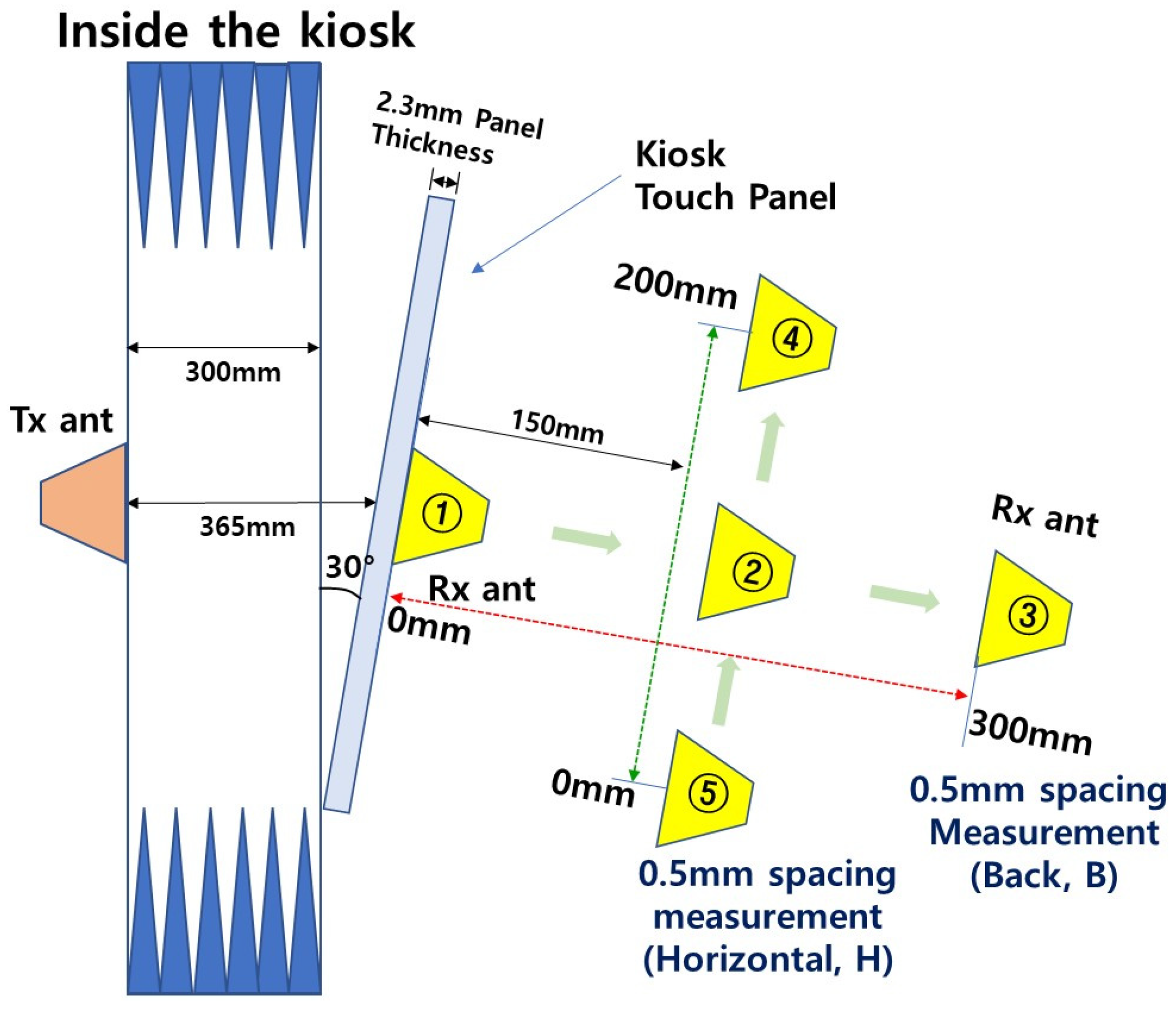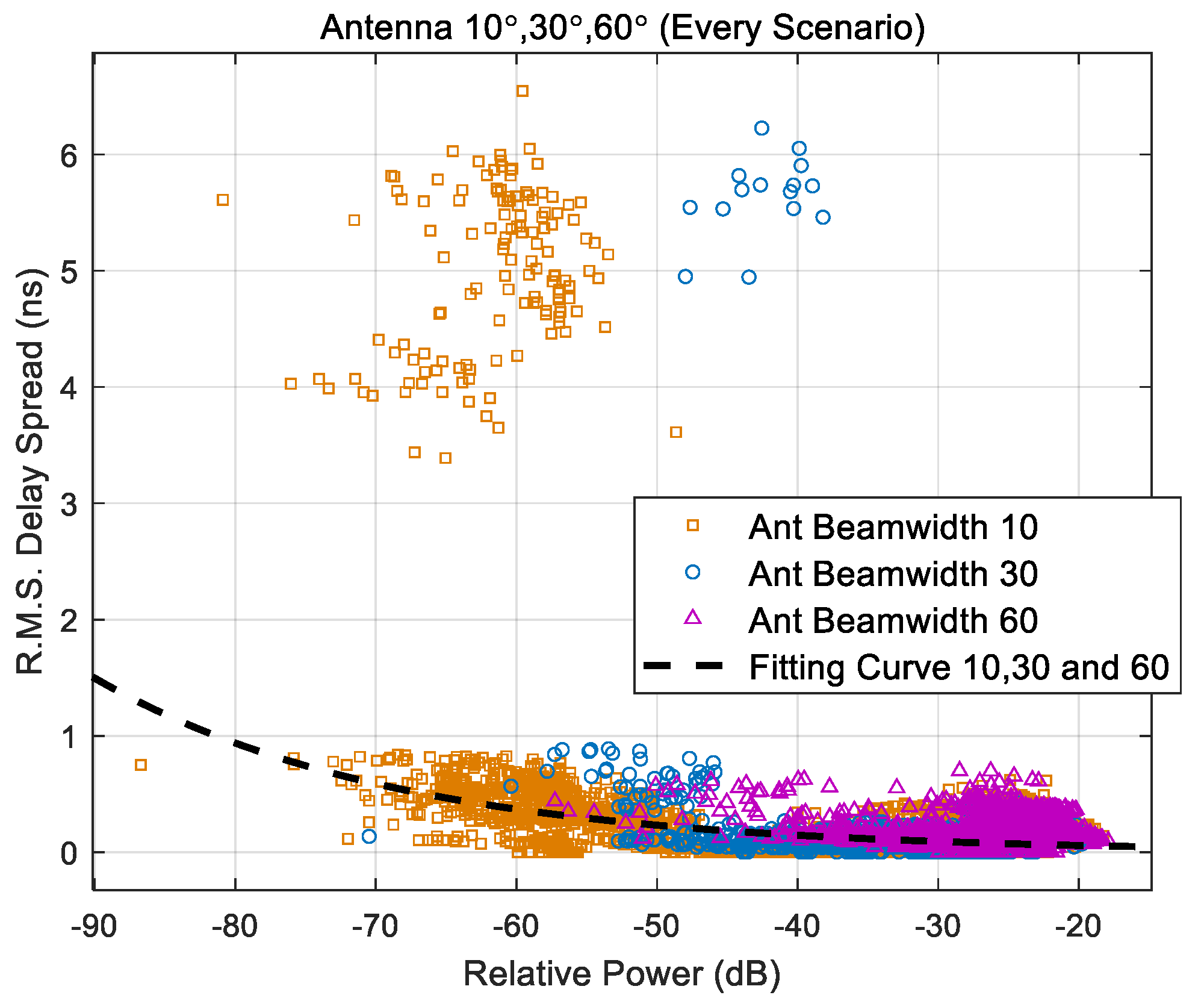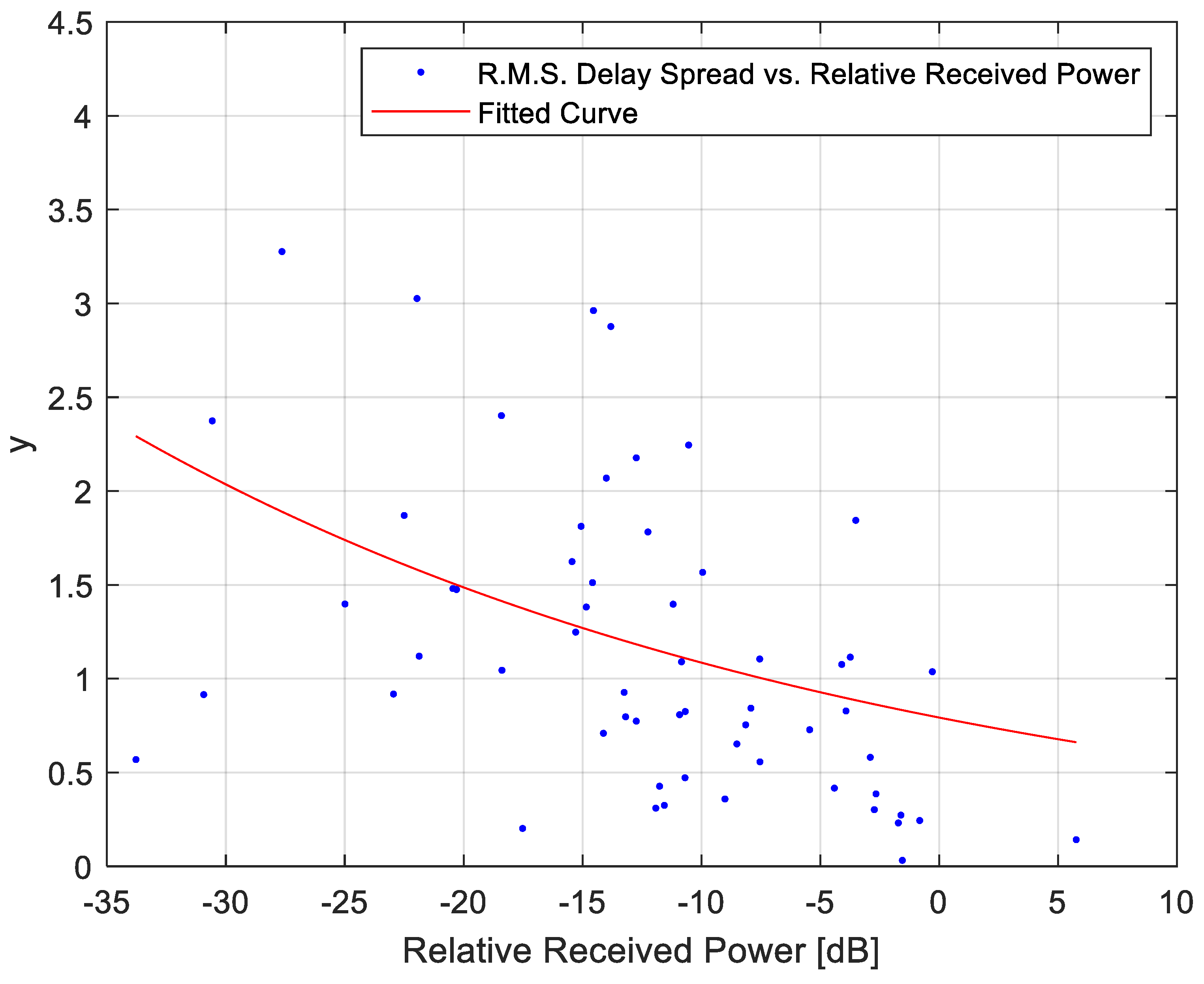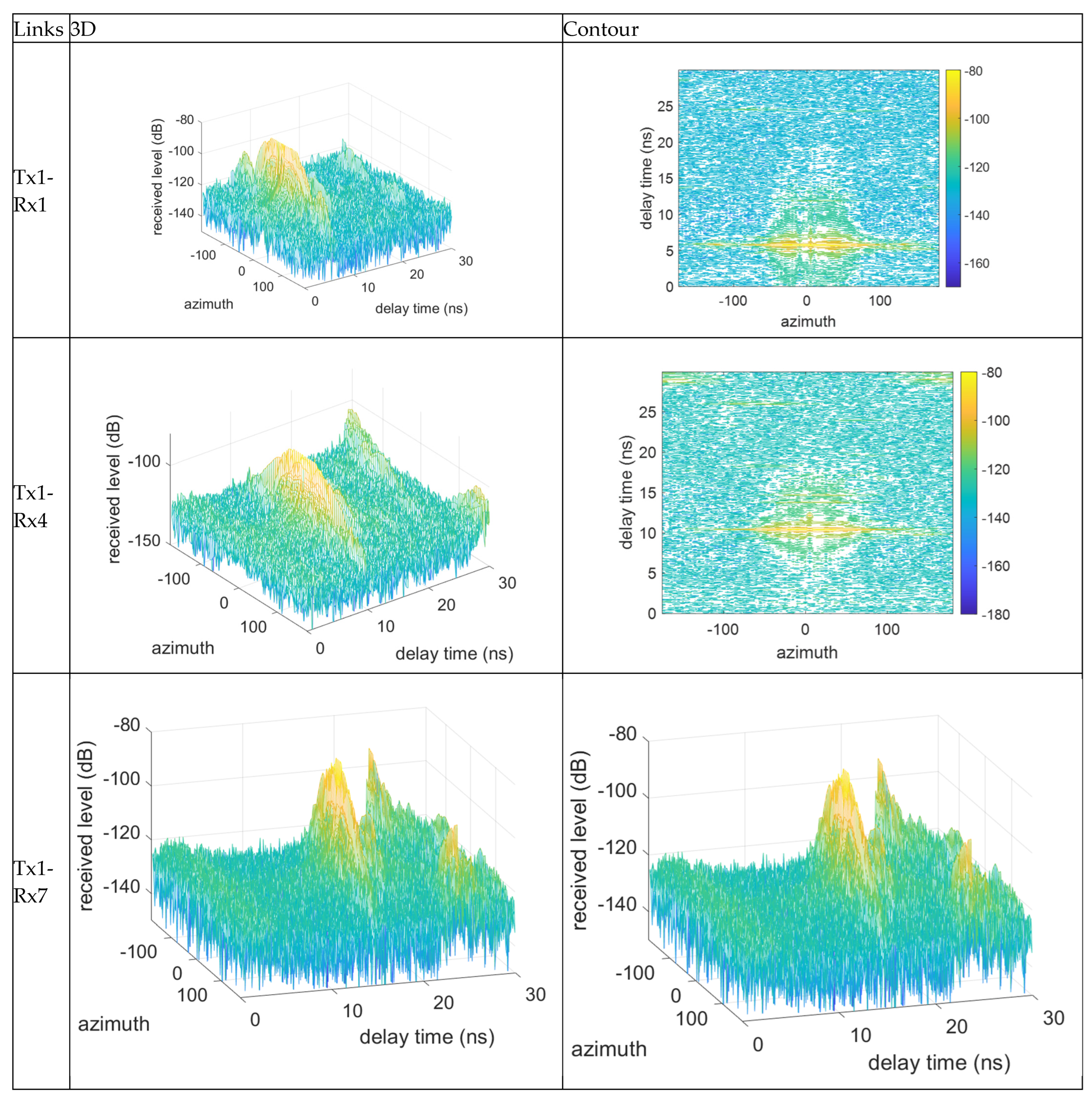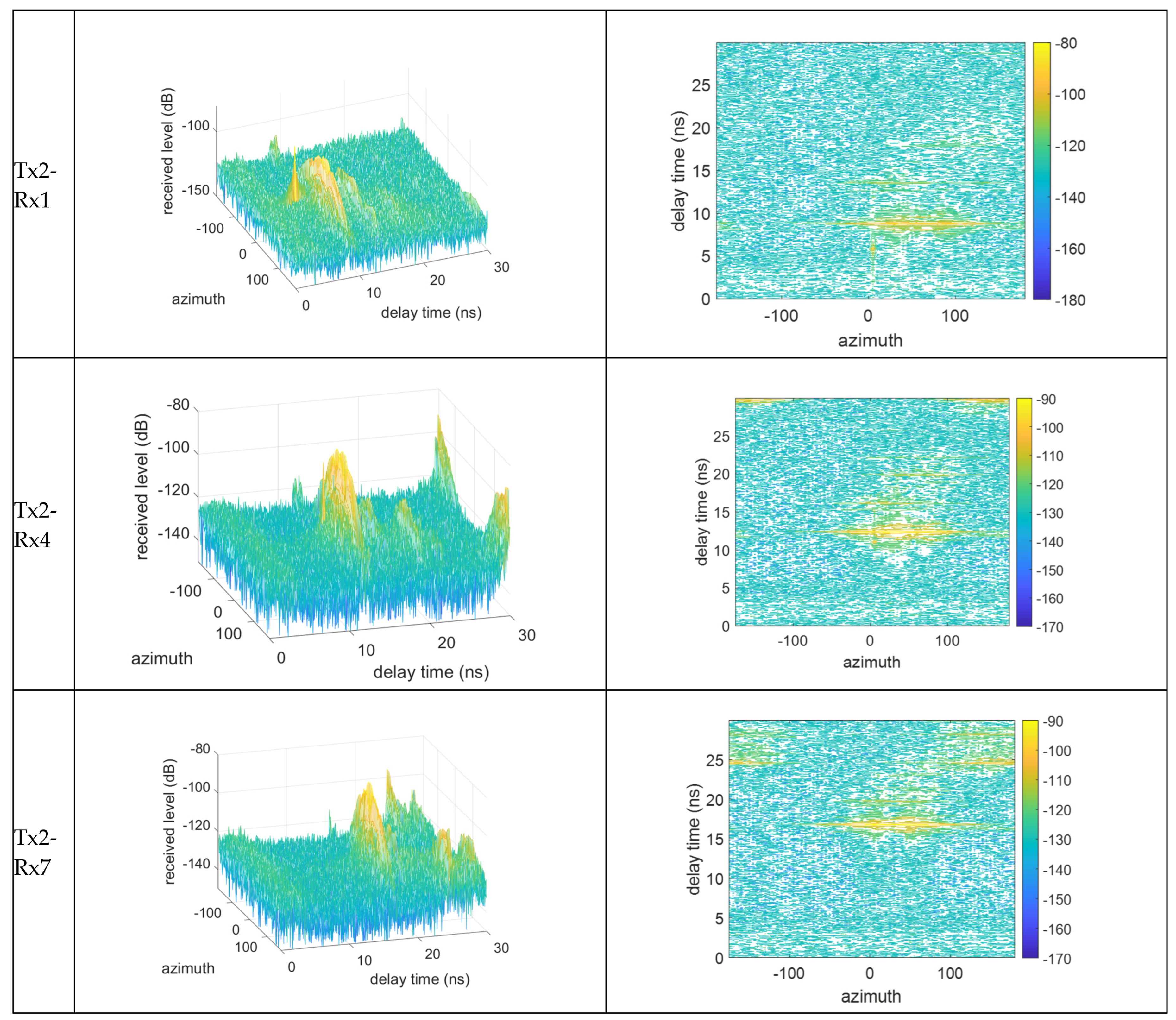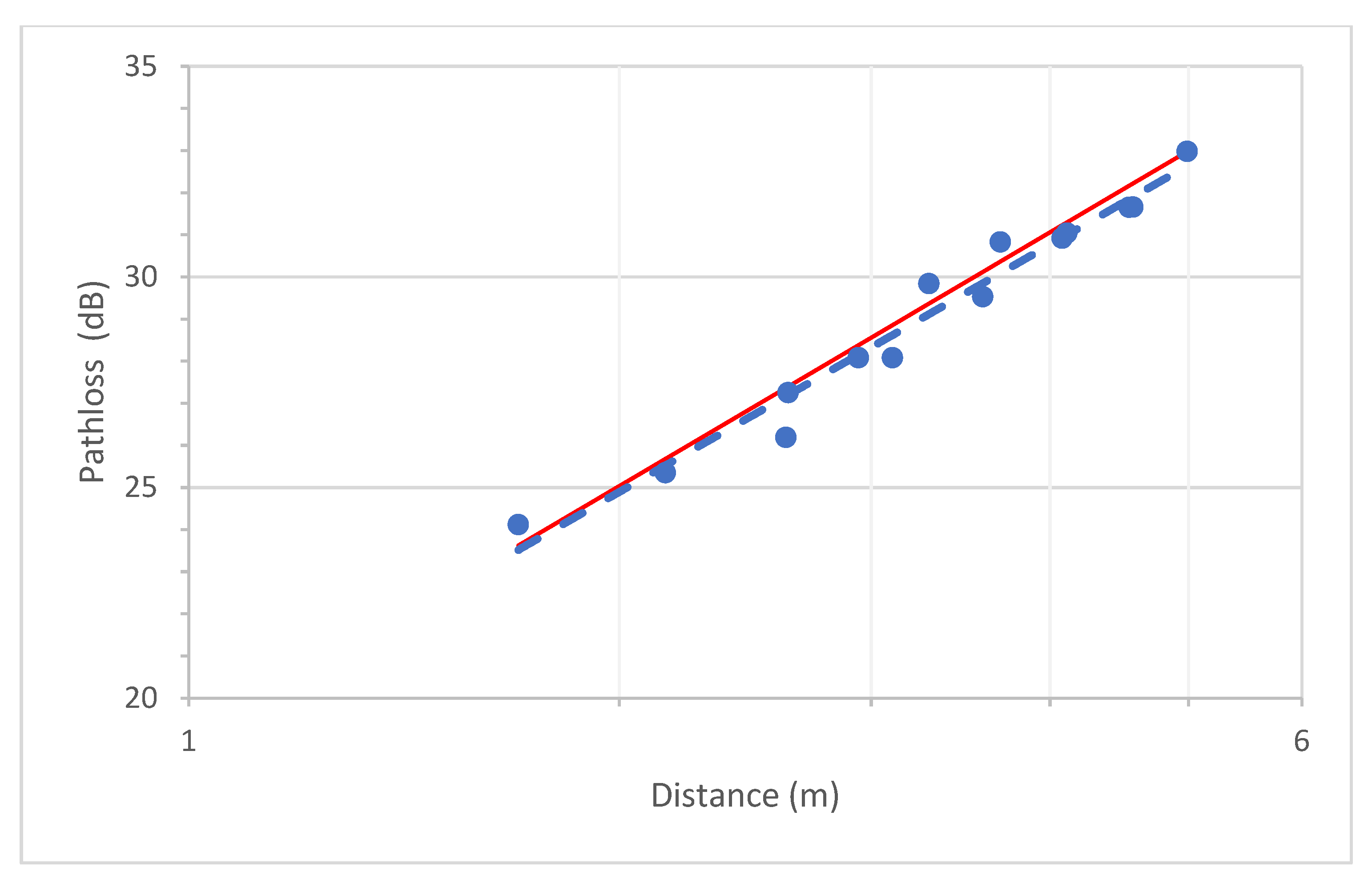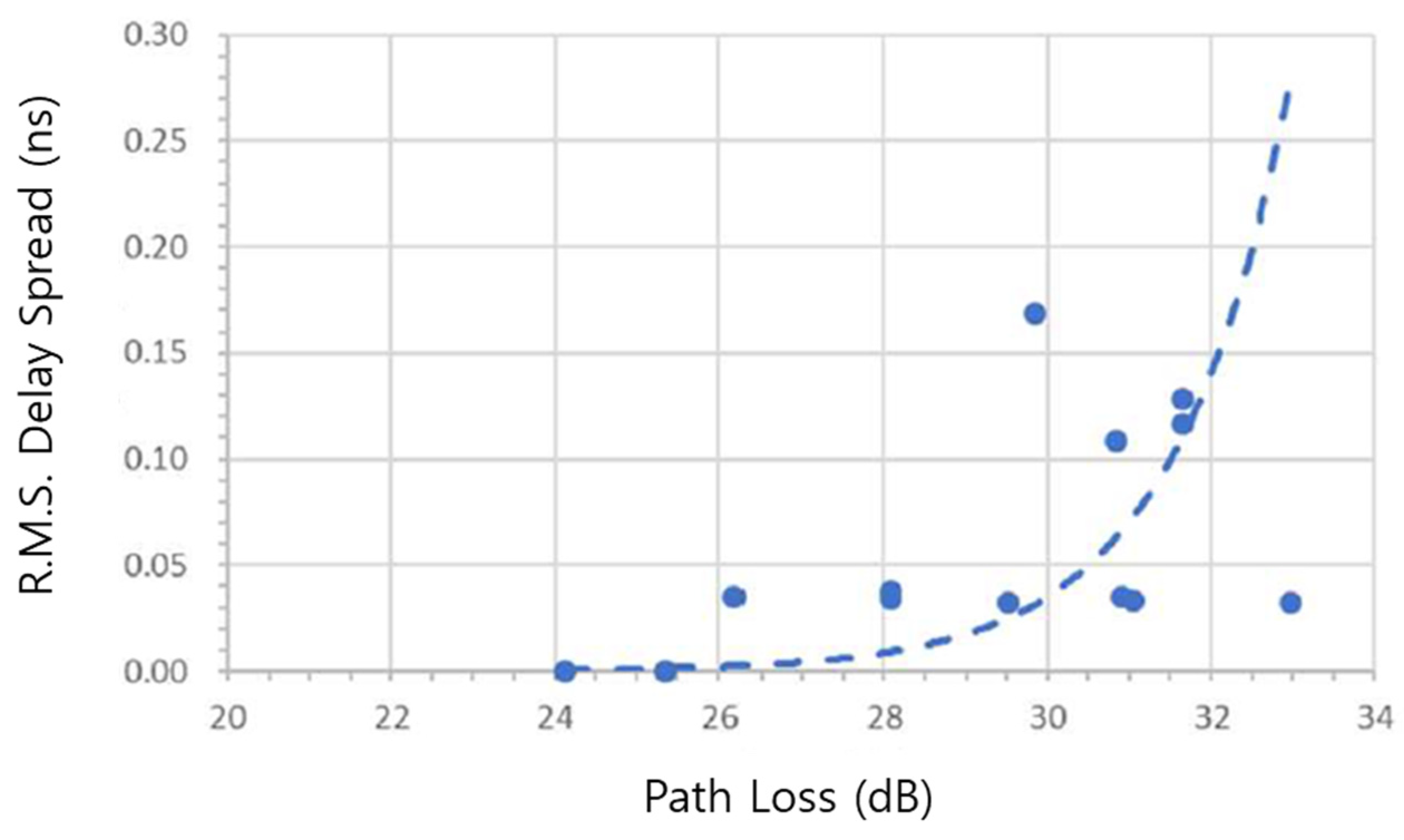Figure 1.
Transmitter and receiver device. (left: transmitter, right: receiver).
Figure 1.
Transmitter and receiver device. (left: transmitter, right: receiver).
Figure 2.
Measurement environment for the kiosk data downloading system.
Figure 2.
Measurement environment for the kiosk data downloading system.
Figure 3.
Top view of measurement Scenario #1.
Figure 3.
Top view of measurement Scenario #1.
Figure 4.
Top view of measurement Scenario #2.
Figure 4.
Top view of measurement Scenario #2.
Figure 5.
Top view of measurement Scenario #3.
Figure 5.
Top view of measurement Scenario #3.
Figure 6.
Rack measurement system configuration.
Figure 6.
Rack measurement system configuration.
Figure 7.
Rack measurement environment.
Figure 7.
Rack measurement environment.
Figure 8.
Rack measurement system plain figure.
Figure 8.
Rack measurement system plain figure.
Figure 9.
Intra-device environment.
Figure 9.
Intra-device environment.
Figure 10.
Photos of radio paths.
Figure 10.
Photos of radio paths.
Figure 11.
Tiny case size.
Figure 11.
Tiny case size.
Figure 12.
Intra-device measurement photo.
Figure 12.
Intra-device measurement photo.
Figure 13.
Laboratory measurement side and top views.
Figure 13.
Laboratory measurement side and top views.
Figure 14.
Picture of measurements at transmitter locations 1 (upper) and 2 (lower).
Figure 14.
Picture of measurements at transmitter locations 1 (upper) and 2 (lower).
Figure 15.
Relative received power according to the Tx-Rx distance in Scenarios #1, 2, and 3. (blue line: actual measurements, red line: trend line).
Figure 15.
Relative received power according to the Tx-Rx distance in Scenarios #1, 2, and 3. (blue line: actual measurements, red line: trend line).
Figure 16.
CDF of the relative received power.
Figure 16.
CDF of the relative received power.
Figure 17.
CDF of the R.M.S. delay results for Scenarios #1 to #3.
Figure 17.
CDF of the R.M.S. delay results for Scenarios #1 to #3.
Figure 18.
CDF of the R.M.S. delay spread in Scenario #1.
Figure 18.
CDF of the R.M.S. delay spread in Scenario #1.
Figure 19.
CDF of the R.M.S. delay spread in Scenario #2.
Figure 19.
CDF of the R.M.S. delay spread in Scenario #2.
Figure 20.
CDF of the R.M.S. delay spread in Scenario #3.
Figure 20.
CDF of the R.M.S. delay spread in Scenario #3.
Figure 21.
CDF of the R.M.S. delay results in measurement Scenario #3 except for the panel.
Figure 21.
CDF of the R.M.S. delay results in measurement Scenario #3 except for the panel.
Figure 22.
CDF of the relative received power with and without the panel.
Figure 22.
CDF of the relative received power with and without the panel.
Figure 23.
Channel impulse response according to the measurement scenario and antenna beamwidth.
Figure 23.
Channel impulse response according to the measurement scenario and antenna beamwidth.
Figure 24.
R.M.S. delay spread with relative received power.
Figure 24.
R.M.S. delay spread with relative received power.
Figure 25.
CDF of relative power according to the obstructions.
Figure 25.
CDF of relative power according to the obstructions.
Figure 26.
CDF of the R.M.S delay spread according to the obstructions.
Figure 26.
CDF of the R.M.S delay spread according to the obstructions.
Figure 27.
Examples of the channel impulse response. (Orange line: 5 deg beamwidth, Blue line: 60 deg beamwidth).
Figure 27.
Examples of the channel impulse response. (Orange line: 5 deg beamwidth, Blue line: 60 deg beamwidth).
Figure 28.
R.M.S. delay spread with relative received power. (The colored lines represent the respective trend lines).
Figure 28.
R.M.S. delay spread with relative received power. (The colored lines represent the respective trend lines).
Figure 29.
Measured PDP for the intra-device environment (tiny).
Figure 29.
Measured PDP for the intra-device environment (tiny).
Figure 30.
CDF for the intra-device environment.
Figure 30.
CDF for the intra-device environment.
Figure 31.
R.M.S. delay spread model for the intra-device environment according to the device size (antenna beamwidth of 60°).
Figure 31.
R.M.S. delay spread model for the intra-device environment according to the device size (antenna beamwidth of 60°).
Figure 32.
R.M.S. delay spread model for all device cases and beamwidths.
Figure 32.
R.M.S. delay spread model for all device cases and beamwidths.
Figure 33.
Results at some links and 3D and contour plots.
Figure 33.
Results at some links and 3D and contour plots.
Figure 34.
Path loss of selected the strongest levels. (The dots are actual measurements, the dotted lines are trend lines).
Figure 34.
Path loss of selected the strongest levels. (The dots are actual measurements, the dotted lines are trend lines).
Figure 35.
Picture of measurements at Tx1 and Tx2. (The dots are actual measurements, the dotted lines are trend lines).
Figure 35.
Picture of measurements at Tx1 and Tx2. (The dots are actual measurements, the dotted lines are trend lines).
Table 1.
Measurement parameters.
Table 1.
Measurement parameters.
| Parameters | Value | Remark |
|---|
| Frequency | 275~295 GHz | Center: 285 GHz |
| Bandwidth | 20 GHz | |
| IF Filter Bandwidth | 10 kHz | |
| Frequency Points | 1201 | |
| Frequency Step Size | 16.67 MHz | |
| Time Domain Resolution | 0.05 ns | 1/20 GHz |
| Time Domain Range | 30 ns | 1200 × 0.05/2 |
Table 2.
The shortest distances of all radio paths.
Table 2.
The shortest distances of all radio paths.
| Tx-Rx Path (mm) | F-R | F-Sa1 | F-Sa2 | F-Sa3 | F-Sa4 | F-Sa5 | Sb1-Sa1 | - |
| Big | 375 | 110 | 158 | 207 | 256 | 303 | 125 | - |
| Small | 310 | 65 | 111 | 158 | 208 | 257 | 123 | - |
| Tx-Rx Path (mm) | Sb1-Sa2 | Sb1-Sa3 | Sb2-Sa1 | Sb2-Sa2 | Sb2-Sa3 | Sb2-Sa4 | Sb2-Sa5 | - |
| Big | 90 | 75 | 214 | 168 | 125 | 90 | 75 | - |
| Small | 87 | 65 | 212 | 166 | 123 | 87 | 71 | - |
| Tx-Rx Path (mm) | Ba-Bb1 | Ba-Bb2 |
| Big | 68 | 88 | 108 | 128 | 121 | 133 | 147 | 162 |
| Small | 28 | 48 | 68 | - | 104 | 111 | 121 | - |
Table 3.
The shortest distances (mm) between Tx and Rx inside the PC case (tiny). Unit: mm.
Table 3.
The shortest distances (mm) between Tx and Rx inside the PC case (tiny). Unit: mm.
| Tx-Rx Path (mm) | F-R | F-Sa1 | F-Sa2 | F-Sa3 | Sb1-Sa1 |
| Tiny Case | 195 | 107 | 91.6 | 81.1 | 45 |
| Tx-Rx Path (mm) | Sb1-Sa2 | Sb1-Sa3 | Sb2-Sa1 | Sb2-Sa2 | Sb2-Sa3 |
| Tiny Case | 60.4 | 74.5 | 60.4 | 45 | 60.4 |
Table 4.
Comparative summary table of the measurement scenarios.
Table 4.
Comparative summary table of the measurement scenarios.
| Scenario | Measurement
Distance | Obstructions | Antenna
Beamwidths | Environment Type | Key Features |
|---|
| Kiosk-based data downloading | 0.1–0.3 m | PET panel (2.3 mm thick), with/without tilt | 10°, 30°, 60° | Semi-enclosed | Short-range, panel penetration/reflection effects |
| Inter-rack communication (data center) | ~0.3–1.0 m | LAN cables, small mesh panel, none | 30°, 60° | Semi-enclosed rack space | Multipath from in-rack obstructions |
| Intra-device communication | 0.03–0.38 m (varies by path) | Internal components, PCB structures | 5°, 60° | Fully enclosed | Strong multipath in confined space |
| Experimental laboratory environment | 1.5–4.5 m | None (controlled environment) | 60° | Open indoor lab | Reference channel for model validation |
Table 5.
Cumulative distribution function values at 10%, 50%, and 90% according to the antenna beamwidth for each measurement scenario.
Table 5.
Cumulative distribution function values at 10%, 50%, and 90% according to the antenna beamwidth for each measurement scenario.
| Scenario | Antenna Beamwidth | 10% | 50% | 90% |
|---|
| #1 | 10° | 0 ns | 0.104 ns | 0.382 ns |
| 30° | 0 ns | 0.089 ns | 0.231 ns |
| 60° | 0.038 ns | 0.124 ns | 0.379 ns |
| #2 | 10° | 0 ns | 0.072 ns | 0.120 ns |
| 30° | 0 ns | 0.075 ns | 0.123 ns |
| 60° | 0.052 ns | 0.1112 ns | 0.150 ns |
| #3 | 10° | 0.068 ns | 0.369 ns | 4.840 ns |
| 30° | 0 ns | 0.097 ns | 0.178 ns |
| 60° | 0.051 ns | 0.118 ns | 0.151 ns |
Table 6.
Percentage of delay spread greater than 1 nanosecond in measurement Scenario #3.
Table 6.
Percentage of delay spread greater than 1 nanosecond in measurement Scenario #3.
| Antenna Beamwidth | 10° | 30° | 60° |
|---|
| R.M.S Delay Spread > 1 ns (%) | 13.2% | 1.5% | 0% |
Table 7.
Relative received power according to antenna beam width and kiosk panel.
Table 7.
Relative received power according to antenna beam width and kiosk panel.
| Antenna Beamwidth | 10° | 30° | 60° |
|---|
| With the Kiosk Panel | −38.89 dB | −30.99 dB | −26.63 dB |
| Without the Kiosk Panel | −33.23 dB | −22.24 dB | −16.44 dB |
Table 8.
The coefficients of the delay spread model with different values of antenna beamwidth.
Table 8.
The coefficients of the delay spread model with different values of antenna beamwidth.
| \ | A | B | |
|---|
| Ant Beamwidth 10 | 0.05306 | −4.156 | 0.9752 |
| Ant Beamwidth 30 | 0.02873 | −3.46 | 0.9739 |
| Ant Beamwidth 60 | 0.0269 | −2.694 | 0.7596 |
| Total | 0.04671 | −3.801 | 0.9785 |
Table 9.
Cumulative distribution function values at 10%, 50%, and 90% according to the antenna beamwidth for each obstruction and antenna beamwidth.
Table 9.
Cumulative distribution function values at 10%, 50%, and 90% according to the antenna beamwidth for each obstruction and antenna beamwidth.
| | Antenna
Beamwidth | R.M.S. Delay Spread Coefficient (ns) |
|---|
| 10% | 50% | 90% |
|---|
| Lan Cable | 30° | 0.04 | 0.111 | 0.281 |
| 60° | 0.1 | 0.194 | 0.754 |
| Mesh Panel | 30° | 0 | 0.098 | 0.252 |
| 60° | 0.08 | 0.179 | 0.355 |
| Nothing | 30° | 0 | 0.056 | 0.154 |
| 60° | 0.037 | 0.11 | 0.157 |
Table 10.
Received level and R.M.S. delay spread in the intra-device scenario.
Table 10.
Received level and R.M.S. delay spread in the intra-device scenario.
| Radio Path | F_R | F_Sa1 | F_Sa2 | F_Sa3 | F_Sa4 | F_Sa5 | Sb1_Sa1 |
| Relative received level (dB) | Big | 5° | −7.58 | −69.78 | −57.64 | −52.12 | −55.47 | −56.27 | −73.08 |
| 10° | −21.99 | −73.84 | −56.92 | −61.64 | −64.17 | −57.04 | −42.36 |
| 60° | −51.87 | −57.52 | −56.55 | −64.54 | −60.46 | −68.83 | −61.98 |
| Small | 5° | −9.41 | −73.87 | −57.12 | −51.67 | −62.17 | −58.21 | −59.57 |
| 10° | −21.23 | −65.07 | −56.56 | −63.80 | −60.81 | −54.69 | −51.74 |
| 60° | −53.43 | −48.21 | −57.65 | −52.84 | −50.57 | −62.56 | −51.15 |
| Radio Path | Sb1_Sa2 | Sb1_Sa3 | Sb2_Sa1 | Sb2_Sa2 | Sb2_Sa3 | Sb2_Sa4 | Sb2_Sa5 |
| Relative received level (dB) | Big | 5° | −59.48 | −0.44 | −66.5 | −57.75 | −52.6 | −54.65 | −0.13 |
| 10° | −39.60 | −10.93 | −60.07 | −59.74 | −54.99 | −43.2 | −11.43 |
| 60° | −52.82 | −49.95 | −67.99 | −58.03 | −57.57 | −50.14 | −39.82 |
| Small | 5° | −52.88 | −0.83 | −60.83 | −61.96 | −46.10 | −60.28 | −1.60 |
| 10° | −44.45 | −7.22 | −63.54 | −60.33 | −47.92 | −52.72 | −7.08 |
| 60° | −43.15 | −38.69 | −61.01 | −54.98 | −49.58 | −42.50 | −38.24 |
| Radio Path | F_R | F_Sa1 | F_Sa2 | F_Sa3 | F_Sa4 | F_Sa5 | Sb1_Sa1 |
| R.M.S. delay spread (ns) | Big | 5° | 0.099 | 5.396 | 4.326 | 5.091 | 3.51 | 3.401 | 3.978 |
| 10° | 0.586 | 5.43 | 4.824 | 5.517 | 5.757 | 4.659 | 3.363 |
| 60° | 2.450 | 4.023 | 4.374 | 5.112 | 4.924 | 4.927 | 4.177 |
| Small | 5° | 0.334 | 2.436 | 2.729 | 2.455 | 2.707 | 2.750 | 2.749 |
| 10° | 1.069 | 3.259 | 2.7 | 2.768 | 2.898 | 2.435 | 2.226 |
| 60° | 1.707 | 1.904 | 2.128 | 2.386 | 2.119 | 2.536 | 1.746 |
| Radio Path | Sb1_Sa2 | Sb1_Sa3 | Sb2_Sa1 | Sb2_Sa2 | Sb2_Sa3 | Sb2_Sa4 | Sb2_Sa5 |
| R.M.S. delay spread (ns) | Big | 5° | 3.824 | 0.001 | 4.854 | 5.238 | 5.144 | 4.186 | 0.116 |
| 10° | 3.127 | 0.224 | 4.893 | 5.625 | 3.316 | 2.553 | 0.218 |
| 60° | 2.789 | 1.855 | 4.354 | 4.571 | 3.166 | 1.967 | 0.652 |
| Small | 5° | 2.424 | 0.177 | 2.523 | 2.579 | 1.443 | 1.502 | 0.197 |
| 10° | 2.128 | 0.177 | 2.593 | 2.984 | 1.866 | 1.763 | 0.211 |
| 60° | 1.558 | 1.019 | 1.992 | 1.957 | 1.564 | 1.264 | 0.846 |
| Board distance (mm) | 70 | 90 | 110 | 130 |
| Radio Path | Ba_Bb1 | Ba_Bb2 | Ba_Bb1 | Ba_Bb2 | Ba_Bb1 | Ba_Bb2 | Ba_Bb1 | Ba_Bb2 |
| Relative received level (dB) | Big | 5° | −7.86 | −70.25 | −12.01 | −69.36 | −14.85 | −71.39 | −17.10 | −66.00 |
| 10° | −12.32 | −63.87 | −11.81 | −66.59 | −12.13 | −61.41 | −16.00 | −61.98 |
| 60° | | | −45.99 | −54.94 | −41.54 | −65.26 | −42.34 | −52.49 |
| Small | 5° | −4.34 | −77.98 | −3.13 | −69.49 | −5.04 | −63.73 | | |
| 10° | −4.43 | −74.03 | −6.69 | −69.09 | −9.6 | −63.83 | | |
| 60° | −31.78 | −63.62 | −40.40 | −56.21 | −41.74 | −62.28 | | |
| R.M.S. delay spread (ns) | Big | 5° | 0.358 | 3.328 | 0.416 | 3.064 | 0.347 | 3.074 | 0.413 | 3.712 |
| 10° | 0.21 | 3.508 | 0.266 | 3.335 | 0.326 | 2.589 | 0.296 | 2.446 |
| 60° | | | 0.591 | 2.38 | 1.252 | 2.927 | 1.447 | 2.396 |
| Small | 5° | 0.222 | 1.395 | 0.334 | 1.356 | 0.442 | 1.178 | | |
| 10° | 0.076 | 1.442 | 0.128 | 1.394 | 0.11 | 1.494 | | |
| 60° | 0.193 | 1.302 | 0.253 | 1.448 | 0.618 | 1.269 | | |
| Board distance (mm) | 30 | 50 | 70 | | |
Table 11.
The coefficients of delay spread.
Table 11.
The coefficients of delay spread.
| | | | |
| Big | −0.03 | −0.5 | 0.653 |
| Small | −0.02 | −0.5 | 0.514 |
Table 12.
Statistics of the R.M.S. delay spread for intra-device environments.
Table 12.
Statistics of the R.M.S. delay spread for intra-device environments.
| Statistics | Max | Min | Average | Median | STD |
|---|
R.M.S.
delay spread (ns) | 4.139 | 0.032 | 1.197 | 0.982 | 0.875 |




